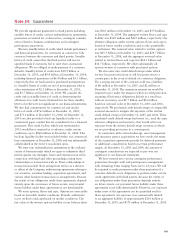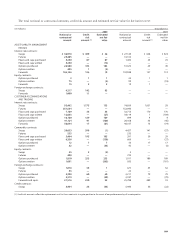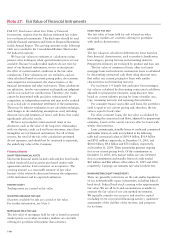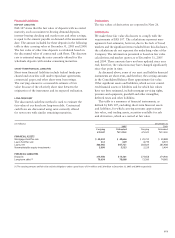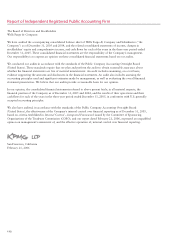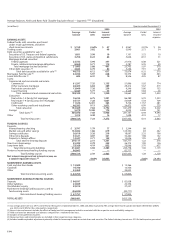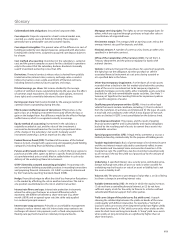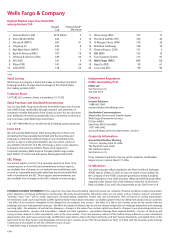Wells Fargo 2005 Annual Report Download - page 117
Download and view the complete annual report
Please find page 117 of the 2005 Wells Fargo annual report below. You can navigate through the pages in the report by either clicking on the pages listed below, or by using the keyword search tool below to find specific information within the annual report.
115
Collateralized debt obligations: Securitized corporate debt.
Core deposits: Deposits acquired in a bank’s natural market area,
counted as a stable source of funds for lending.These deposits
generally have a predictable cost and customer loyalty.
Core deposit intangibles: The present value of the difference in cost of
funding provided by core deposit balances compared with alternative
funding with similar terms assigned to acquired core deposit balances
by a buyer.
Cost method of accounting: Investment in the subsidiary is carried at
cost, and the parent company accounts for the subsidiary’s operations
only to the extent that the subsidiary declares dividends. Generally
used if investment ownership is less than 20%.
Derivatives: Financial contracts whose value is derived from publicly
traded securities, interest rates, currency exchange rates or market
indices. Derivatives cover a wide assortment of financial contracts,
including forward contracts, futures, options and swaps.
Diluted earnings per share: Net income divided by the average
number of common shares outstanding during the year, plus the effect
of common stock equivalents (for example, stock options, restricted
share rights and convertible debentures) that are dilutive.
Earnings per share: Net income divided by the average number of
common shares outstanding during the year.
Effectiveness/ineffectiveness (of derivatives): Effectiveness is the
gain or loss on a hedging instrument that exactly offsets the loss or
gain on the hedged item. Any difference would be the effect of hedge
ineffectiveness, which is recognized currently in earnings.
Equity method of accounting: Investment in the subsidiary is
originally recorded at cost, and the value of the investment is
increased or decreased based on the investor’s proportional share
of the change in the subsidiary’s net worth. Generally used if
investment ownership is 20% or more but less than 50%.
Federal Reserve Board (FRB): The Board of Governors of the Federal
Reserve System, charged with supervising and regulating bank holding
companies, including financial holding companies.
Futures and forward contracts: Contracts in which the buyer agrees to
purchase and the seller agrees to deliver a specific financial instrument
at a predetermined price or yield. May be settled either in cash or by
delivery of the underlying financial instrument.
GAAP (Generally accepted accounting principles): Accounting rules
and conventions defining acceptable practices in recording transactions
and preparing financial statements. U.S. GAAP is primarily determined
by the Financial Accounting Standards Board (FASB).
Hedge: Financial technique to offset the risk of loss from price fluctuations
in the market by offsetting the risk in another transaction.The risk in
one position counterbalances the risk in another transaction.
Interest rate floors and caps: Interest rate protection instruments
where the seller pays the buyer an interest differential, which
represents the difference between a short-term rate (e.g., three-
month LIBOR) and an agreed-upon rate (the strike rate) applied
to a notional principal amount.
Interest rate swap contracts: Primarily an asset/liability management
strategy to reduce interest rate risk. Interest rate swap contracts are
exchanges of interest rate payments, such as fixed-rate payments for
floating-rate payments, based on notional principal amounts.
Glossary
Mortgage servicing rights: The rights to service mortgage loans for
others, which are acquired through purchases or kept after sales or
securitizations of originated loans.
Net interest margin: The average yield on earning assets minus the
average interest rate paid for deposits and debt.
Notional amount: A number of currency units, shares, or other units
specified in a derivative contract.
Office of the Comptroller of the Currency (OCC): Part of the U.S.
Treasury department and the primary regulator for banks with
national charters.
Options: Contracts that grant the purchaser, for a premium payment,
the right, but not the obligation, to either purchase or sell the
associated financial instrument at a set price during a period or
at a specified date in the future.
Other-than-temporary impairment: A write-down of certain assets
recorded when a decline in the fair market value below the carrying
value of the asset is considered not to be temporary. Applies to
goodwill, mortgage servicing rights, other intangible assets, securities
available for sale and nonmarketable equity securities. (See Note 1 –
Summary of Significant Accounting Policies for impairment policies
for specific categories of assets.)
Qualifying special-purpose entities (QSPE): A trust or other legal
vehicle that meets certain conditions, including (1) that it is distinct
from the transferor, (2) activities are limited, and (3) the types of assets
it may hold and conditions under which it may dispose of noncash
assets are limited. A QSPE is not consolidated on the balance sheet.
Securitize/securitization: The process and the result of pooling
financial assets together and issuing liability and equity obligations
backed by the resulting pool of assets to convert those assets into
marketable securities.
Special-purpose entities (SPE): A legal entity, sometimes a trust or a
limited partnership, created solely for the purpose of holding assets.
Taxable-equivalent basis: Basis of presentation of net interest income
and the net interest margin adjusted to consistently reflect income
from taxable and tax-exempt loans and securities based on a 35%
marginal tax rate.The yield that a tax-free investment would provide
to an investor if the tax-free yield was “grossed up” by the amount of
taxes not paid.
Underlying: A specified interest rate, security price, commodity price,
foreign exchange rate, index of prices or rates or other variable. An
underlying may be the price or rate of an asset or liability, but is not
the asset or liability itself.
Value at risk: The amount or percentage of value that is at risk of being
lost from a change in prevailing interest rates.
Variable interest entity (VIE): An entity in which the equity investors
(1) do not have a controlling financial interest, or (2) do not have
sufficient equity at risk for the entity to finance its activities without
subordinated financial support from other parties.
Yield curve (shape of the yield curve, flat yield curve): A graph
showing the relationship between the yields on bonds of the same
credit quality with different maturities. For example, a “normal”,or
“positive”, yield curve exists when long-term bonds have higher yields
than short-term bonds. A “flat” yield curve exists when yields are the
same for short-term and long-term bonds. A “steep” yield curve exists
when yields on long-term bonds are significantly higher than on
short-term bonds.


